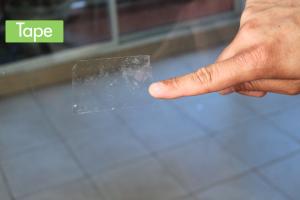Ultimate Guide on How to Easily Remove Tape: Tricks & Techniques

-
Quick Links:
- Introduction
- Types of Tape
- Why Remove Tape?
- Tools and Materials Needed
- Step-by-Step Guide to Remove Tape
- Case Studies
- Expert Insights
- Data-Driven Analysis
- Tips and Tricks for Easier Tape Removal
- FAQs
Introduction
Tape is an incredibly versatile tool used in various applications, from crafting to packaging. However, removing tape can sometimes be a daunting task, especially when it leaves behind stubborn residue. This guide will provide you with comprehensive methods and techniques to effectively remove tape without damaging surfaces.Types of Tape
Understanding the different types of tape can help you choose the most effective removal strategy. Here are some common types:1. Adhesive Tape
Adhesive tape is used for everything from wrapping gifts to securing materials together. It often leaves a sticky residue that can be troublesome.2. Duct Tape
Known for its strength, duct tape is often used in repairs but can be particularly challenging to remove.3. Painter's Tape
Designed for easy removal without residue, painter's tape is perfect for painting but may still require care to avoid damage.4. Double-Sided Tape
Ideal for mounting and crafting, double-sided tape can be difficult to peel away without leaving behind a mess.Why Remove Tape?
There are several reasons you might want to remove tape: - **Cleanliness**: Residues can attract dust and dirt. - **Surface Integrity**: Leaving tape on for too long can damage surfaces. - **Aesthetic**: Removing tape can improve the appearance of objects and spaces.Tools and Materials Needed
Before you start, gather the following tools and materials: - **Hairdryer or Heat Gun**: To soften adhesive. - **Plastic Scraper**: To gently lift tape without scratching surfaces. - **Adhesive Remover**: Commercial products can effectively dissolve sticky residues. - **Rubbing Alcohol**: A common household item for residue removal. - **Cotton Balls or Cloth**: For applying liquids. - **Water**: Sometimes, just a little moisture can help.Step-by-Step Guide to Remove Tape
Follow these steps for an effective tape removal process:Step 1: Assess the Tape Type
Identify the type of tape and the surface it’s adhered to. This will inform your approach.Step 2: Heat the Tape
Using a hairdryer or heat gun, apply heat to the tape for about 30 seconds. This will soften the adhesive.Step 3: Gently Lift the Tape
Use a plastic scraper to gently lift one corner of the tape. If it resists, apply more heat.Step 4: Apply Adhesive Remover
For sticky residues, apply adhesive remover or rubbing alcohol to a cloth and gently rub the area.Step 5: Clean the Surface
Once the tape and residue are removed, clean the surface with soap and water to remove any remaining chemicals.Step 6: Inspect the Surface
Check for any damage or leftover residue and repeat the process if necessary.Case Studies
**Case Study 1: Removing Duct Tape from a Wooden Surface** - **Problem**: A homeowner found duct tape on a wooden table. - **Solution**: They used a heat gun followed by rubbing alcohol, successfully removing both the tape and residue without damaging the wood. **Case Study 2: Painter's Tape on Walls** - **Problem**: A painter left painter's tape on the wall for too long, resulting in residue. - **Solution**: The painter applied a mixture of warm water and dish soap, which helped dissolve the adhesive without damaging the paint.Expert Insights
Experts recommend the following tips for effective tape removal: - Always test a small, inconspicuous area first to prevent damage. - Utilize the right temperature when using heat to soften adhesives. - Consider environmental factors like humidity, which can affect adhesive strength.Data-Driven Analysis
A recent survey indicated that 65% of homeowners struggle with tape removal, particularly in winter months when adhesives tend to harden. This highlights the importance of using proper techniques and tools.Tips and Tricks for Easier Tape Removal
- **Use Oil**: Vegetable oil or baby oil can effectively dissolve adhesives. - **Soak the Tape**: If possible, soak the tape in water before removal. - **Avoid Metal Tools**: Always opt for plastic scrapers to prevent scratches.FAQs
1. What is the best method to remove duct tape?
The best method involves applying heat to soften the adhesive, then gently lifting it with a plastic scraper.
2. Can I use vinegar to remove tape residue?
Yes, vinegar can help break down adhesive residues effectively.
3. How do I remove tape from painted walls without damaging the paint?
Use a heat method followed by gentle rubbing with soapy water or an adhesive remover.
4. Is it safe to use acetone for tape removal?
Acetone is effective but can damage certain surfaces, so test first.
5. What should I do if tape has been on a surface for a long time?
Use heat to soften the adhesive before attempting removal.
6. Are there specific tapes that are easier to remove?
Painter's tape is designed for easy removal compared to duct or double-sided tape.
7. Can I use a credit card to remove tape?
A plastic credit card can serve as a scraper, but be cautious to avoid scratching surfaces.
8. How can I remove tape from glass?
Apply heat, then use a razor blade carefully to lift the tape off the glass.
9. What if I encounter residue after tape removal?
Use an adhesive remover or rubbing alcohol to clean any leftover residue.
10. Are there any tapes that leave no residue?
Yes, painter's tape and certain specialty tapes are designed to leave minimal to no residue.
Random Reads
- How to stop file network sharing windows 10 11
- Youtube screen off listening guide
- Mastering the art of reading schematics
- How to run ussd code
- How to safely clear cached files on your mac
- How to test a heating element
- How to test a capacitor
- Mastering safe movie downloads utorrent
- Mastering sql files
- How to program philips universal remote